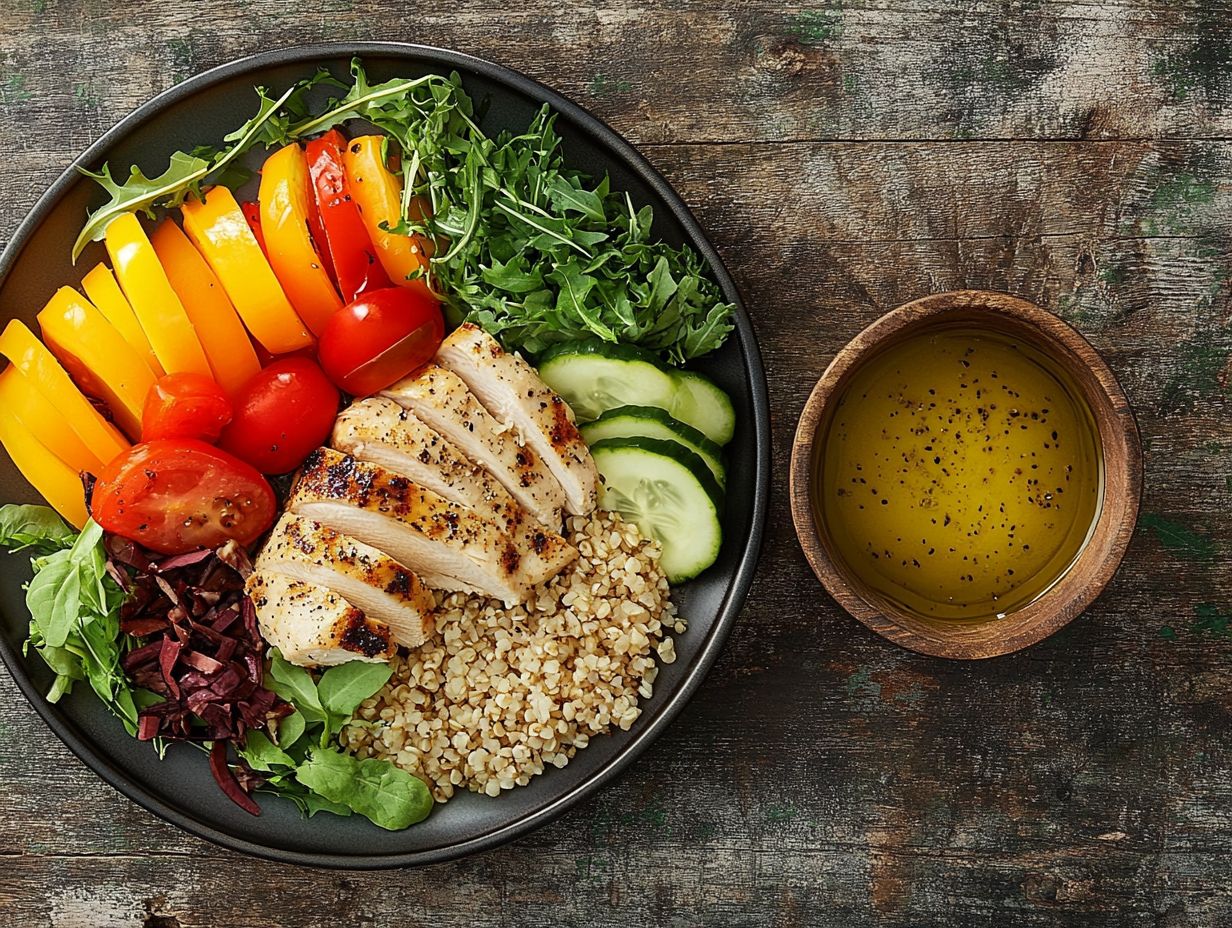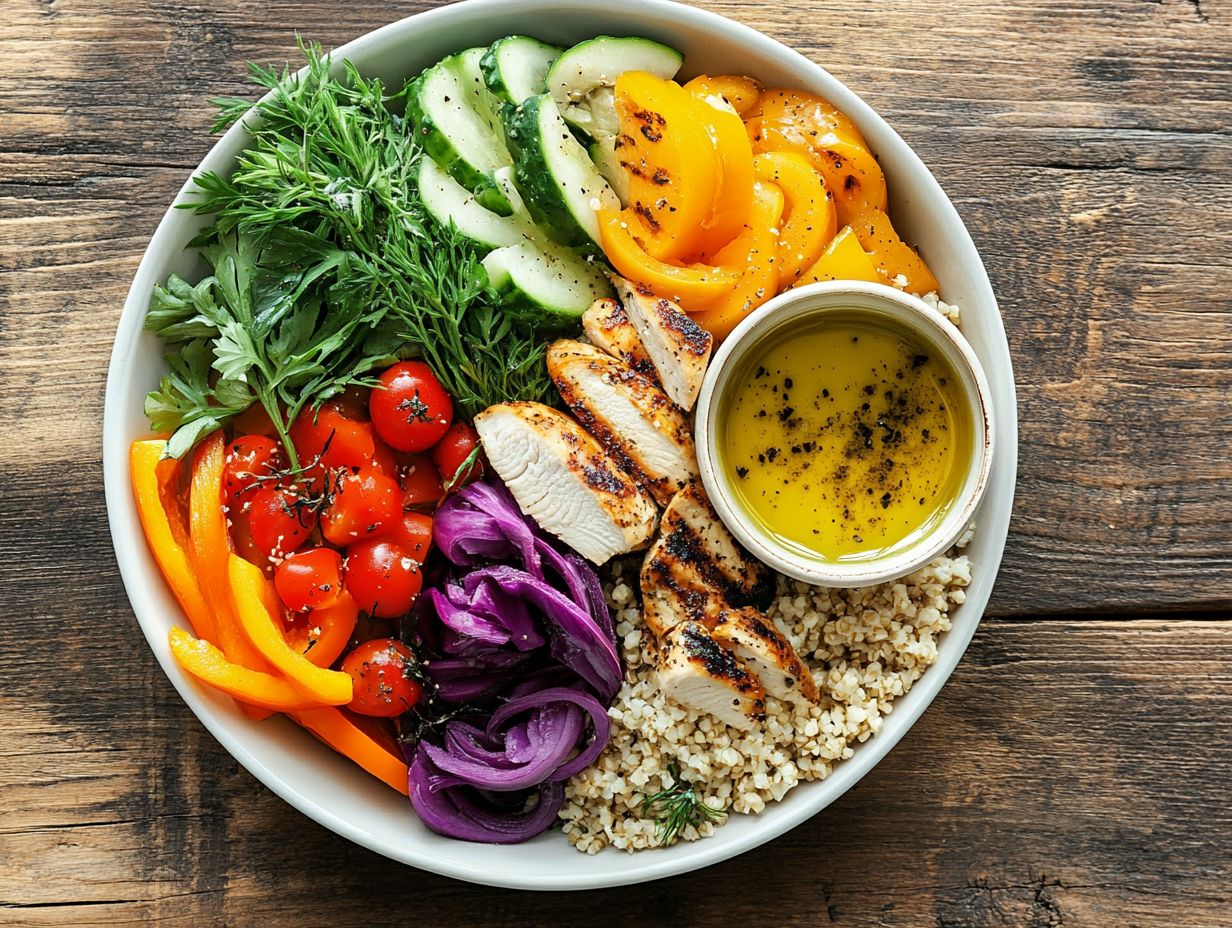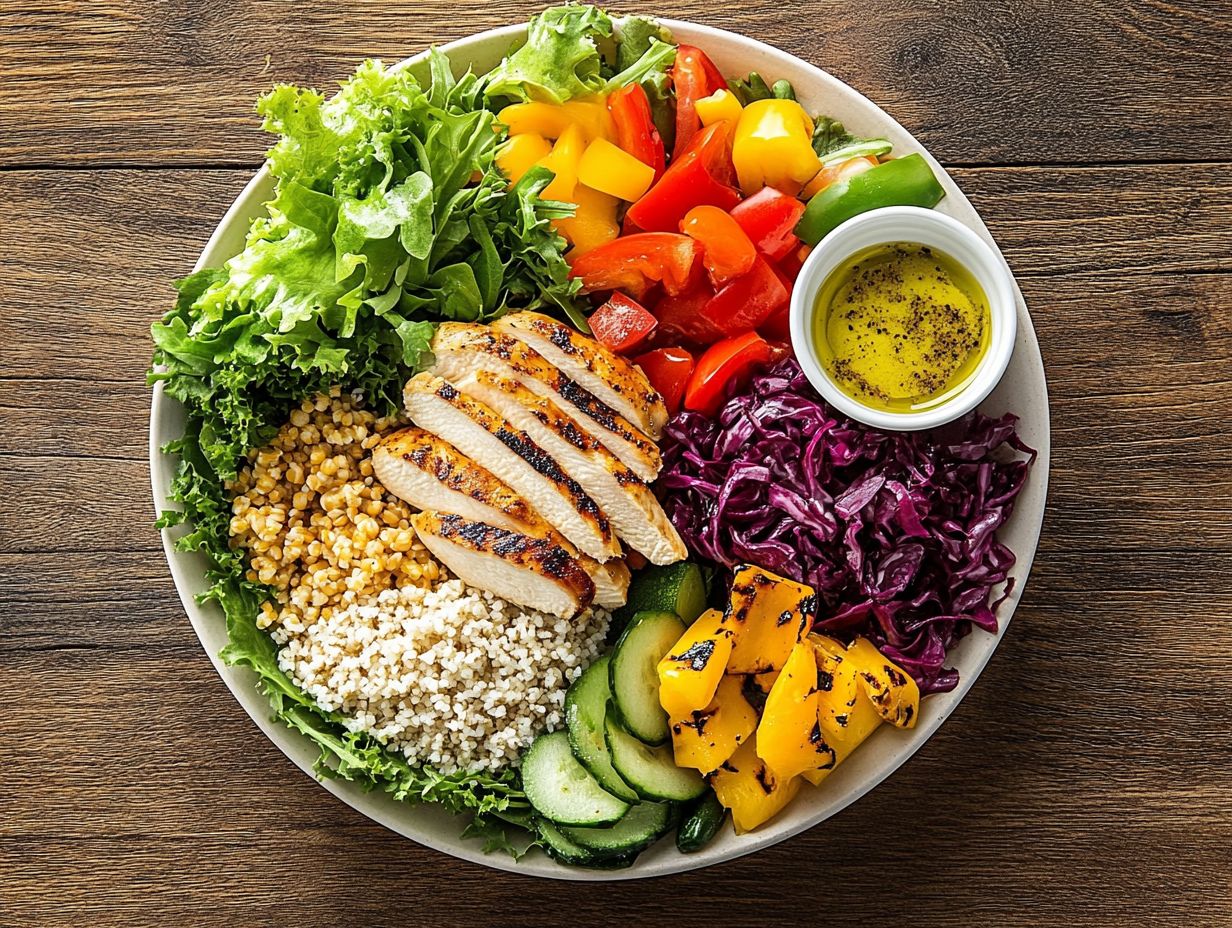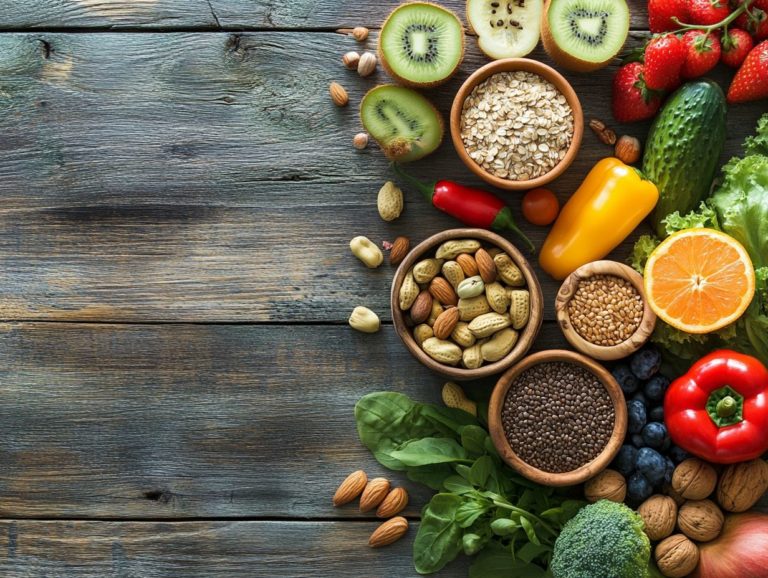How to Build a Balanced Plate with Holistic Nutrition?
Holistic nutrition transcends merely what’s on your plate; it embodies a comprehensive approach that nurtures your mind, body, and spirit.
This article delves into the foundational principles of holistic nutrition, highlighting the essential components of a balanced meal while emphasizing the significance of variety and moderation in your diet.
Get ready to explore practical tips for crafting a holistic meal plan, along with insights into the vital practice of mindful eating.
Embrace this opportunity to transform your relationship with food and nurture your overall well-being.
Contents
- Key Takeaways:
- The Basics of Holistic Nutrition
- Building a Balanced Plate
- The Importance of Variety and Moderation
- Tips for Creating a Holistic Meal Plan
- Incorporating Mindful Eating
- Frequently Asked Questions
- What is the concept of building a balanced plate with holistic nutrition?
- Why is building a balanced plate important for overall health and wellness?
- How can I ensure that my plate is balanced with holistic nutrition?
- What types of foods should I include on my balanced plate for holistic nutrition?
- Can I still enjoy my favorite foods while building a balanced plate with holistic nutrition?
- Are there any specific dietary restrictions or considerations when building a balanced plate with holistic nutrition?
Key Takeaways:

- Incorporate a variety of food groups, including fruits, vegetables, whole grains, and lean proteins.
- Practice mindful eating by paying attention to your body s hunger and fullness cues.
- Utilize meal planning strategies to create a nourishing meal plan.
The Basics of Holistic Nutrition
Holistic nutrition invites you to embrace a comprehensive approach to your eating habits, one that acknowledges not just the nutritional benefits of food, but also the emotional and psychological dimensions of consumption. It encourages you to explore the interconnectedness of various food groups and their vital roles in your overall wellness and health, guided by principles from esteemed institutions like the Harvard T.H. Chan School of Public Health and the dietary guidelines issued by organizations such as the USDA.
By adopting holistic nutrition, you can cultivate a lifestyle that prioritizes balanced meals, mindful eating practices, and the advantages of enjoying seasonal produce.
The Benefits of Holistic Nutrition
Understanding the concept of holistic nutrition unveils a wealth of benefits that enhance not just your physical health but also your overall wellness.
Holistic nutrition focuses on whole foods. It highlights how different dietary components interact to help you cultivate a balanced lifestyle. This approach can significantly reduce your risk of chronic diseases, like heart disease and cancer, which are long-lasting health conditions that can have significant effects on your life. It emphasizes choosing nutrient-rich foods while encouraging mindful eating habits, leading to greater awareness of your dietary patterns.
Those who embrace this philosophy often find themselves making healthier decisions, effectively boosting their nutritional index. Such positive dietary habits build resilience against stress, promote vitality, and empower you to take charge of your health in a profound and sustainable manner.
Building a Balanced Plate
Creating a balanced plate is crucial for achieving optimal nutrition, and it starts with a clear understanding of the essential components that contribute to a healthy eating pattern, including how to create a holistic nutrition meal plan.
The Healthy Eating Plate, crafted by experts at Harvard T.H. Chan School of Public Health, offers a practical framework for structuring your meals. By incorporating whole grains, lean protein sources, healthy fats, and a generous serving of non-starchy vegetables, along with a diverse selection of fruits, you can elevate your dining experience while nourishing your body effectively.
Start today by making one small change to your meals!
Key Components of a Holistic Meal

Key components of a holistic meal involve a harmonious blend of whole grains, protein sources, healthy oils, and a vibrant array of fruits and vegetables.
Whole grains act as a powerhouse of dietary fiber, essential for promoting digestive health and maintaining steady energy levels. Incorporating options like quinoa, brown rice, or whole-wheat pasta elevates your nutrient intake and protects you from the drawbacks of refined carbohydrates.
Healthy oils, such as olive oil or avocado oil, add rich flavors while providing healthy fats that are good for your heart. When paired with a colorful assortment of fruits and vegetables brimming with vitamins and antioxidants your meal transforms into a well-rounded, nourishing experience that sustains both your body and mind.
The Importance of Variety and Moderation
Variety and moderation are key to healthy eating! They are essential for achieving nutritional balance and promoting long-term health.
Incorporating a diverse range of foods helps secure a broad spectrum of nutrients while cultivating a sustainable eating approach that harmonizes with seasonal practices. This approach also promotes mindful consumption.
Incorporating Different Food Groups
Make sure to include grains, proteins, fats, fruits, and vegetables in your meals for balanced nutrition and healthy eating habits.
Grains serve as your primary energy source, while proteins are crucial for muscle repair and growth. Healthy fats support brain function and cell repair, and a colorful array of fruits and vegetables provides essential vitamins and minerals.
Achieving the right balance of carbohydrates and proteins can be simple pair whole grains with lean meats or legumes for a satisfying and nutritious plate. It’s also important to avoid sugary beverages, which can lead to energy spikes and crashes, throwing your body off balance.
By making mindful choices, you can start making choices today for a healthier tomorrow!
Tips for Creating a Holistic Meal Plan
Creating a holistic meal plan requires your focus and effort, emphasizing not just nutrition, but also the harmony of flavors and the seasonal availability of ingredients. Mastering effective meal planning simplifies your grocery shopping and cooking process, ensuring meals rich in whole grains, fruits, vegetables, and healthy fats.
Embracing portion control becomes second nature, allowing you to nourish your body with intention and care.
Meal Planning Strategies and Ideas

Meal planning strategies are vital for crafting a comprehensive meal plan that embodies balanced nutrition and incorporates healthy oils for optimal well-being.
Employing effective techniques such as batch cooking allows you to prepare large quantities of food in advance, ensuring you always have nutritious options readily available. Utilizing a meal prep schedule enhances your organization, making it easier to shop for and enjoy a diverse array of food groups throughout the week.
Don t shy away from experimenting with healthy oils like olive or avocado; they not only elevate the flavor of your dishes but also introduce healthy fats into your daily meals.
These strategies work together to create a more varied and satisfying diet, supporting your overall wellness while streamlining the cooking process.
Incorporating Mindful Eating
Incorporating mindful eating into your daily routine profoundly enhances the mind-body connection and cultivates healthier eating habits. By becoming more aware of your eating experience, you empower yourself to make conscious choices that resonate with your eating goals, fostering a deeper understanding of your body s needs.
The Mind-Body Connection in Nutrition
The mind-body connection is crucial in nutrition. Mindfulness cultivates healthier eating habits by tuning in to your body s signals.
Being aware of hunger and satiety cues empowers you to make dietary choices that truly align with your needs.
For example, when you’re fully present during meals, opting for vibrant fruits and vegetables transforms into a delightful experience, allowing you to savor their flavors and textures. By incorporating mindful eating practices like slowing down to relish each bite and minimizing distractions you can significantly enhance your relationship with food.
Check out these fun tips to enhance your mindful eating journey:
- Set aside designated meal times free from screens.
- Focus on the colors and aromas of your dishes.
- Take deep breaths before diving in.
These simple strategies help with better digestion and deepen your understanding of nutrition, guiding you toward more balanced choices.
Frequently Asked Questions
What is the concept of building a balanced plate with holistic nutrition?

Building a balanced plate with holistic nutrition involves incorporating whole, natural, and nutrient-dense foods in appropriate portions. For more guidance, check out this resource on how to plan meals with holistic nutrition in mind to create a well-rounded and nourishing meal.
Why is building a balanced plate important for overall health and wellness?
A balanced plate provides the essential vitamins, minerals, and macronutrients needed for optimal physical, mental, and emotional well-being. Learning how to meal prep for holistic nutrition also helps prevent chronic diseases and promotes a healthy weight.
How can I ensure that my plate is balanced with holistic nutrition?
A good rule of thumb is to fill half of your plate with non-starchy vegetables, a quarter with lean protein, and a quarter with whole grains or starchy vegetables. This ensures a balance of nutrients and helps control portion sizes.
What types of foods should I include on my balanced plate for holistic nutrition?
In addition to non-starchy vegetables, lean protein, and whole grains, it’s important to include healthy fats, such as avocado, nuts, and olive oil, and a variety of fruits, herbs, and spices for added flavor and nutrition.
Can I still enjoy my favorite foods while building a balanced plate with holistic nutrition?
Yes, incorporating small portions of your favorite foods is encouraged in a balanced plate. The key is to focus on whole, nutrient-dense foods as the foundation of your plate and to enjoy indulgences in moderation.
Are there any specific dietary restrictions or considerations when building a balanced plate with holistic nutrition?
Holistic nutrition focuses on individualized and mindful eating, so any dietary restrictions or preferences can be taken into account when creating a balanced plate. Understanding what foods are essential in holistic nutrition is also crucial. It’s important to listen to your body and choose foods that make you feel your best.






